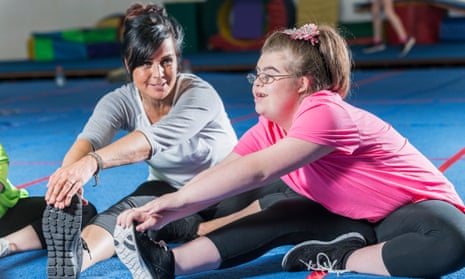Disabled children and young people should get 20 minutes of exercise each day and strength and balance activity three times a week in the first ever physical activity guidelines released for them by the four chief medical officers in the UK.
The recommendations, underpinned by research from Durham University, the University of Bristol and Disability Rights UK, note that the health and wellbeing benefits include stronger muscles and improved confidence.
While chief medical officers have previously issued physical activity guidelines for UK children and young people, it is the first time such recommendations have been made for those with disabilities.
The chief medical officers, Sir Chris Whitty, Sir Michael McBride, Sir Gregor Smith and Sir Frank Atherton, said: “We are delighted to present this report and infographic which are an important step forward in addressing the gap in physical activity guidelines for disabled children and disabled young people.
“We encourage schools, parents, carers and healthcare professionals to communicate and promote these guidelines across their wider professional networks to enable appropriate physical activity opportunities for disabled children and disabled young people in their communities.”
Brett Smith, professor of disability and physical activity at Durham University, who led the work, said while many disabled children and young people wanted to be active, they and their parents often had questions, including whether it was safe for them to exercise and how much they should do. “They don’t have any guidance to say physical activity done at certain levels is really good for you. They need that reassurance that it’s good,” he said.
Indeed, the evidence showed that physical activity could be just as beneficial for disabled children and young people as those who did not have a disability. But Smith said it was also crucial that disabled children and young people had access to spaces such as playgrounds and leisure facilities.
“From a public health perspective, we can say x amount of physical activity is good for you or not, but until we have inclusive environments, until we have equality in those contexts, then children will always struggle, and their parents will always struggle to be able to do that,” he said.
The new guidelines recommend that disabled children and young people aim for 120 to 180 minutes of moderate-to-vigorous intensity aerobic activity a week, or 20 minutes a day, and engage in strength and balance-focused activities around three times a week.
“We don’t have any evidence to make a minutes recommendation for strength and balance,” said Charlie Foster, professor of physical activity and public health at the University of Bristol, who was also involved in developing the guidelines. He said strength and balance-focused activities included dance, yoga and gymnastics.
Foster added that, as for other groups of individuals, all movement mattered and all “bite-size chunks of activity” counted – a phrasing he said was preferred by the disabled children and young people involved in communicating the guidelines.
Smith said that the participants stressed that while the amount of physical activity was a useful message, it was important to them to emphasise equality, inclusivity, fun and exploring what made them feel good.
“The lesson they taught us [is] that public health resources and messages will have more impact if they are co-produced in genuine partnership with people with lived experience,” Foster said. He also suggested the approach could prove useful for other areas of public health, including the uptake of Covid vaccines.
The guidelines did not break down recommendations by different impairment groups, not least because evidence specific to some groups was lacking. Instead the team said it was important for people to find what worked for them, and to tailor exercise to what they could do on that day – a point raised by the disabled children and young people themselves.
The guidelines, said Smith, were important not only from a public health perspective, but also because they covered a group of individuals that were often forgotten.
“If people have forgotten about the health disparities, the health inequalities are just perpetuated implicitly if not explicitly on that,” he said, adding that disabled people had often been overlooked during the Covid pandemic.
“It’s just putting disabled people and disabled young people at the forefront of policy, at the forefront of our agenda, at the forefront of our thinking, because there are so many young disabled people in society,” he said.
